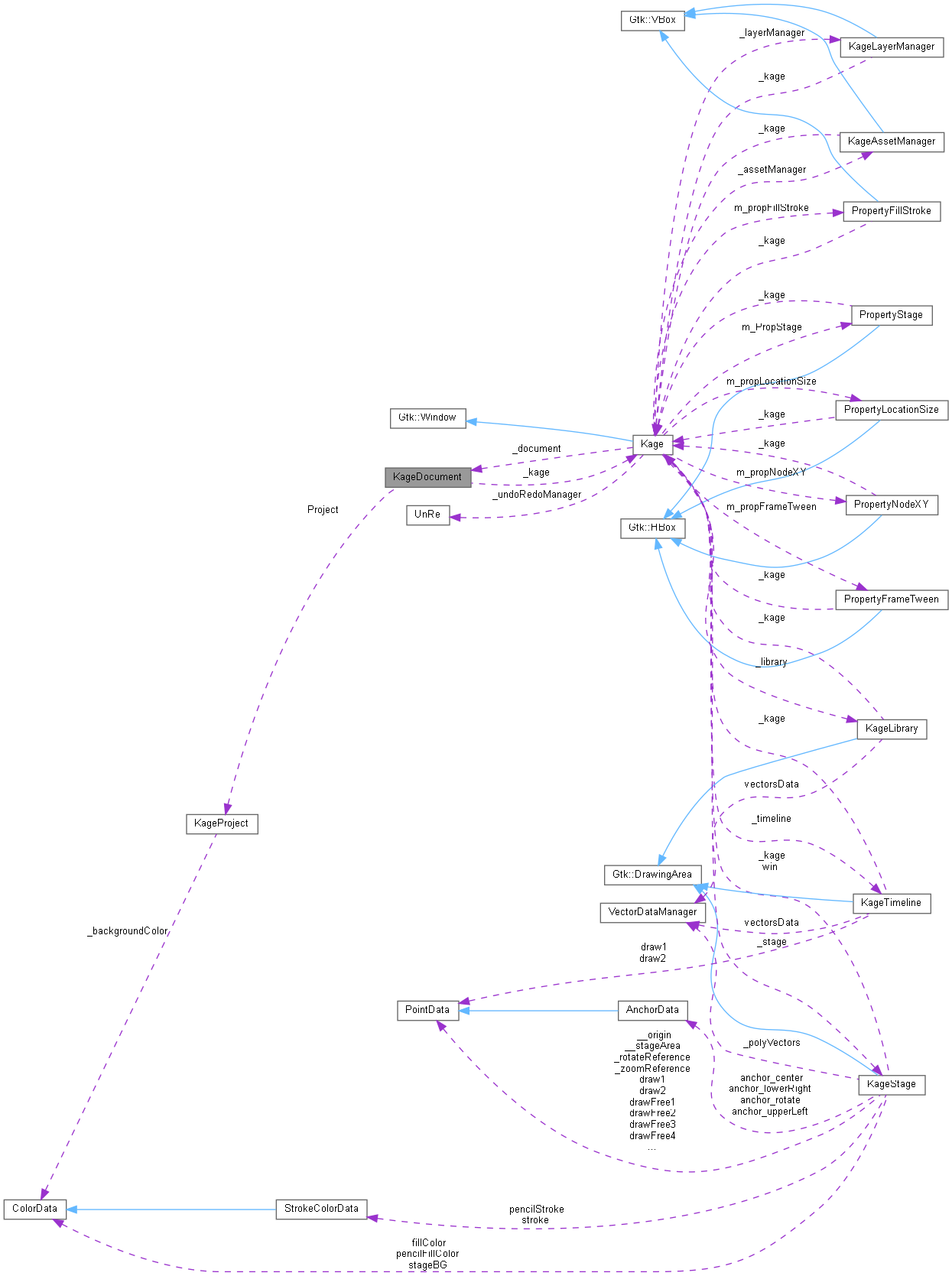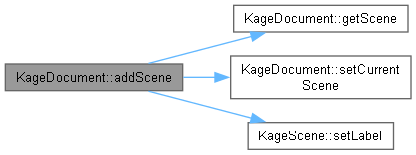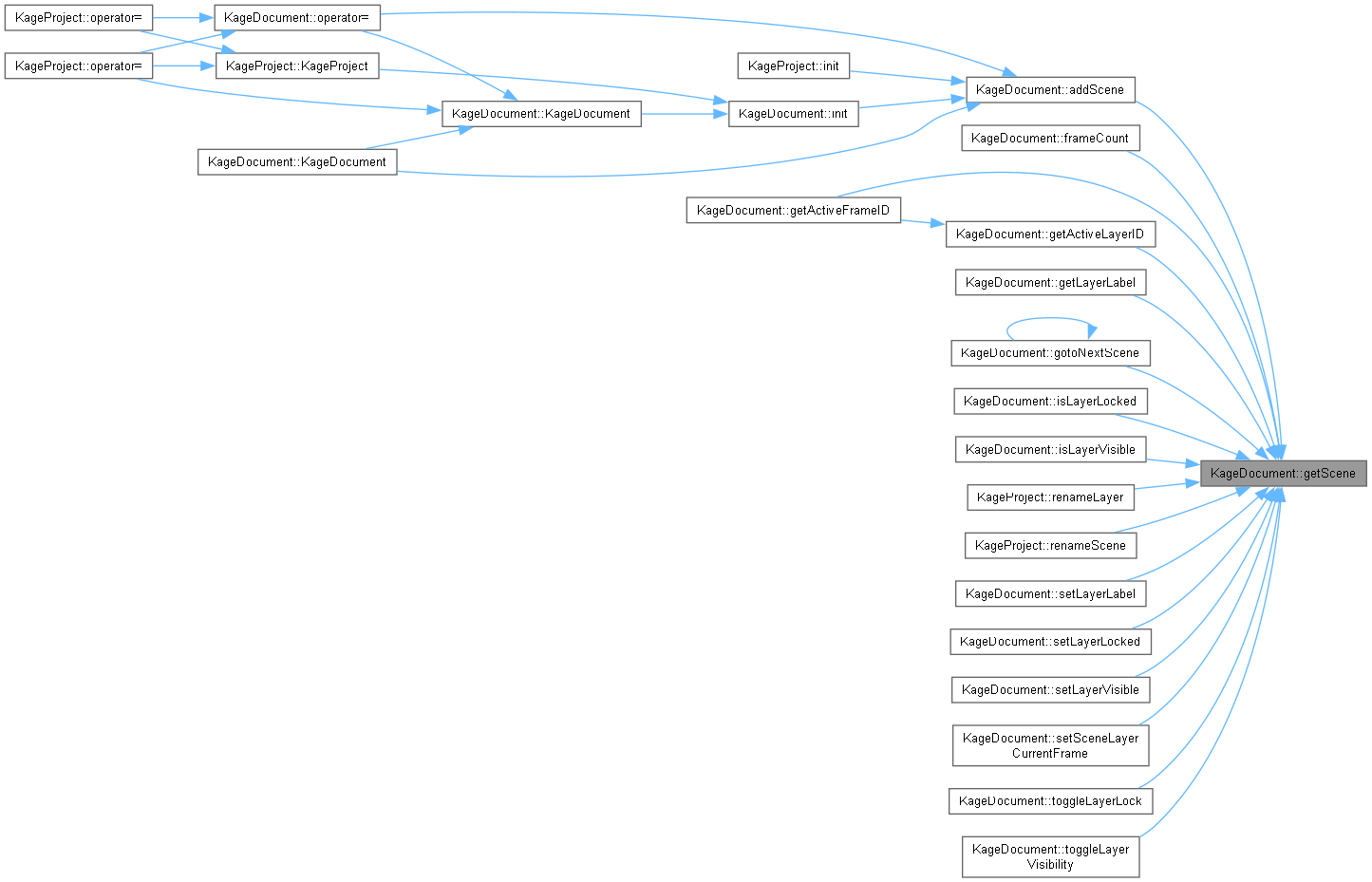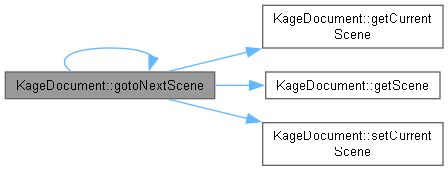#include <document.h>
◆ AssetType
| Enumerator |
|---|
| ASSET_IMAGE | |
| ASSET_VIDEO | |
| ASSET_KAGE | |
◆ KageDocument() [1/2]
| KageDocument::KageDocument |
( |
| ) |
|
◆ KageDocument() [2/2]
◆ ~KageDocument()
| KageDocument::~KageDocument |
( |
| ) |
|
|
virtual |
◆ addScene()
| unsigned int KageDocument::addScene |
( |
std::string | p_sceneLabel, |
|
|
bool | p_asset = false ) |
Used by Kage when creating new Scene, or opening KSF file (even if via KAGE file)
- Returns
- Scene ID of newly created Scene
◆ frameCount()
| unsigned int KageDocument::frameCount |
( |
| ) |
|
◆ getActiveFrameID()
| unsigned int KageDocument::getActiveFrameID |
( |
| ) |
|
◆ getActiveLayerID()
| unsigned int KageDocument::getActiveLayerID |
( |
| ) |
|
◆ getActiveSceneID()
| unsigned int KageDocument::getActiveSceneID |
( |
| ) |
|
◆ getCurrentScene()
| unsigned int KageDocument::getCurrentScene |
( |
| ) |
|
returns activeSceneIndex+1; to get the actual (pointer to) Scene object, use getScene instead
- Returns
- unsigned int activeSceneIndex+1
- See also
- setActiveScene
◆ getLayerLabel()
| std::string KageDocument::getLayerLabel |
( |
| ) |
|
◆ getScene()
◆ gotoNextScene()
| bool KageDocument::gotoNextScene |
( |
| ) |
|
For use by Kage when Play is triggered.
- Returns
- true
-
false
◆ init()
| void KageDocument::init |
( |
| ) |
|
◆ isLayerLocked()
| bool KageDocument::isLayerLocked |
( |
| ) |
|
◆ isLayerVisible()
| bool KageDocument::isLayerVisible |
( |
| ) |
|
◆ isSaved()
| bool KageDocument::isSaved |
( |
| ) |
|
◆ moveSceneDown()
| bool KageDocument::moveSceneDown |
( |
| ) |
|
NOTE: Scenes are organized as index 0 as BOTTOM and last index is TOP
- See also
- moveToBottom() moveToTop() moveUp()
- Returns
- True if successfully moved to bottom
◆ moveSceneToBottom()
| bool KageDocument::moveSceneToBottom |
( |
| ) |
|
◆ moveSceneToTop()
| bool KageDocument::moveSceneToTop |
( |
| ) |
|
◆ moveSceneUp()
| bool KageDocument::moveSceneUp |
( |
| ) |
|
◆ openProject()
| bool KageDocument::openProject |
( |
| ) |
|
◆ openScene()
| unsigned int KageDocument::openScene |
( |
std::string | p_filepath | ) |
|
◆ operator=()
◆ removeAllScenes()
| bool KageDocument::removeAllScenes |
( |
| ) |
|
◆ removeSceneAt()
| bool KageDocument::removeSceneAt |
( |
unsigned int | p_sceneIndex | ) |
|
◆ saveProject()
| bool KageDocument::saveProject |
( |
| ) |
|
◆ saveScene()
| bool KageDocument::saveScene |
( |
unsigned int | p_sceneID | ) |
|
Kage Document will contain several scenes. This will allow saving one Scene to be saved each time.
- Parameters
-
| p_sceneID | which Scene do we want to save? |
- Returns
- true
-
false
◆ setCurrentScene()
| void KageDocument::setCurrentScene |
( |
unsigned int | p_newScene | ) |
|
returns index+1
Used by KageSceneUI.
- Parameters
-
| p_newScene | p_newScene-1 is index |
◆ setCurrentSceneByID()
| void KageDocument::setCurrentSceneByID |
( |
unsigned int | p_newSceneID | ) |
|
◆ setLayerLabel()
| void KageDocument::setLayerLabel |
( |
std::string | p_label | ) |
|
◆ setLayerLocked()
| void KageDocument::setLayerLocked |
( |
bool | p_lock | ) |
|
◆ setLayerVisible()
| void KageDocument::setLayerVisible |
( |
bool | p_visible | ) |
|
◆ setSceneLayerCurrentFrame()
| void KageDocument::setSceneLayerCurrentFrame |
( |
unsigned int | p_frame | ) |
|
◆ toggleLayerLock()
| void KageDocument::toggleLayerLock |
( |
| ) |
|
◆ toggleLayerVisibility()
| void KageDocument::toggleLayerVisibility |
( |
| ) |
|
◆ _activeScene
| unsigned int KageDocument::_activeScene |
will be used to create Unique sceneCtr IDs
◆ _activeSceneID
| unsigned int KageDocument::_activeSceneID |
◆ _activeSceneIndex
| unsigned int KageDocument::_activeSceneIndex |
◆ _displayObjectIsShape
| bool KageDocument::_displayObjectIsShape |
|
static |
◆ _mouseLocation
| GdkPoint KageDocument::_mouseLocation |
|
static |
◆ _saved
| bool KageDocument::_saved |
◆ _scenePtr
◆ ASSET_MODE
| bool KageDocument::ASSET_MODE = false |
|
static |
◆ Assets
| std::vector<Asset> KageDocument::Assets |
◆ sceneCtr
| unsigned int KageDocument::sceneCtr |
◆ Scenes
The documentation for this class was generated from the following files:





































